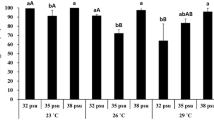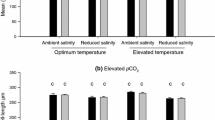Abstract
The response of embryos and larvae of the American oyster,Crassostrea virginica, to copper at various salinity-temperature regimes was studied in the laboratory using response surface methods and factorial analysis. The experimental design was a 3 x 3 x 4 factorial experiment using temperatures of 20, 25, and 30°C, and salinities of 17.5, 22.5, and 27.5 ‰ It was carried out at copper concentrations of 0, 5, 10, and 20 ppb for the embryos and 0, 30, 60, and 90 ppb for the larvae. Statistical analysis indicated that salinity had the greatest effect on the embryos at 0, 5, and 10 ppb copper, but temperature had as great an effect as that of salinity at 20 ppb copper. The capacity of the embryos to adapt to the temperaturesalinity changes was impaired when exposed to 20 ppb copper, as indicated by the shifting of the response center. Temperature had the greatest effect on the larvae when exposed to 30, 60, and 90 ppb copper. The interaction between temperature and salinity was significant only at the higher levels of qopper. Low levels of copper may produce intolerable stress upon the recruitment of oyster embryos during periods of persistently low salinities and low or high temperatures.
Similar content being viewed by others
References
Alderdice, D. F.: Factor combinations: Responses of marine poikilotherms to environmental factors acting in concert. In O. Kinne (ed.): Marine ecology. Vol. I, Environmental factors, Part 3, p. 1659. London: Wiley-Interscience (1972).
Blaxter, J. H. S.: The effect of copper on the eggs and larvae of plaice and herring. J. Mar. Biol. Ass. U.K.57, 849 (1977).
Cairns, J., Jr., A. G. Heath, and B. C. Parker: The effect of temperature upon the toxicity of chemicals to aquatic organisms. Hydrobiologia47, 135 (1975).
Calabrese, A., R. S. Collier, D. A. Nelson, and J. R. MacInnes: The toxicity of heavy metals to embryos of the American oysterCrassostrea virginica. Mar. Biol.18, 162 (1973).
Calabrese, A., and H. C. Davis: The pH tolerance of embryos and larvae ofMercenaria mercenaria andCrassostrea virginica. Biol. Bull.131, 427 (1966).
Calabrese, A., J. R. MacInnes, D. A. Nelson, and J. E. Miller: Survival and growth of bivalve larvae under heavy-metal stress. Mar. Biol.41, 179 (1977).
Connor, P. M.: Acute toxicity of heavy metals to some marine larvae. Mar. Pollut. Bull.3, 190 (1972).
Davis, H. C., and A. Calabrese: Combined effects of temperature and salinity on development of eggs and growth of larvae ofM. mercenaria andC. virginica. Fish. Bull. U.S.63, 634 (1964).
Dehlinger, P., W. F. Fitzgerald, D. F. Paskausky, R. W. Garvine, W. F. Bohlen, S. Y. Feng, A. J. Nalwalk, R. J. Szechtman, C. D. Hunt, D. L. Murphy, C. E. Perkins, and G. M. Ruddy: Investigations on concentrations, distributions, and fates of heavy metal wastes in parts of Long Island Sound. Final report submitted to the Office of Sea Grant Programs, NOAA (1974).
Dixon, W. J.: Biomedical computer programs. Univ. Calif. Publs. Autom. Computation No. 2. Berkeley: Univ. Calif. Press (1971).
Gray, J. S.: Synergistic effects of three heavy metals on growth rates of a marine protozoan. In F. J. Vernberg and W. B. Vernberg (eds.): Pollution and physiology of marine organisms, p. 465. New York: Academic Press (1974).
Gray, J. S.: The effects of salinity, temperature and mercury on mortality of the trocophore larvae ofSerpula vermicularis L. (Annelida: Polychaeta). J. Exp. Mar. Biol. Ecol.23, 127 (1976).
Heslinga, G. A.: Effects of copper on the coral-reef echinoidEchinometra mathaei. Mar. Biol.35, 155 (1976).
Jones, L. H., N. V. Jones, and A. J. Radlett: Some effects of salinity on the toxicity of copper to the polychaeteNereis diversicolor. Estuarine and Coastal Mar. Sci.4, 107 (1976).
Jones, M. B.: Effects of copper on survival and osmoregulation in marine and brackish water isopods (Crustacea). In H. Barnes (ed.): Proc. 9th Eur. Mar. Biol. Symp. p. 419. Aberdeen: Aberdeen Univ. Press (1975).
Loosanoff, V. L., and H. C. Davis: Rearing of bivalve mollusks. In F. S. Russell (ed.): Advances in marine biology. Vol. I. London: Academic Press (1963).
MacInnes, J. R., and A. Calabrese: Response of embryos of the American oyster,Crassostrea virginica, to heavy metals at different temperatures. In D. S. McLusky and A. J. Berry (eds.): Physiology and behavior of marine organisms. Proc. 12th Eur. Mar. Biol. Symp. p. 195. Oxford: Pergamon Press (1978).
McLeese, D. W.: Toxicity of copper at two temperatures and three salinities to the American lobster (Homarus americanus). J. Fish. Res. Bd. Can.31, 1949 (1974).
Okubo, K., and T. Okubo: Study on the bio-assay method for the evaluation of water pollution. II. Use of the fertilized eggs of sea urchins and bivalves. Bull. Tokai Reg. Fish. Res. Lab.32, 131 (1962).
Olson, K. R., and R. C. Harrel: Effect of salinity on acute toxicity of mercury, copper, and chromium forRangia cuneata (Pelecypoda, Mactridae). Contrib. Mar. Sci. Univ. Tex.17, 9 (1973).
Thurberg, F. P., M. A. Dawson, and R. S. Collier: Effects of copper and cadmium on osmoregulation and oxygen consumption in two species of estuarine crabs. Mar. Biol.23, 171 (1973).
Vernberg, W. B., and J. Vernberg: The synergistic effects of temperature, salinity, and mercury on survival and metabolism of the adult fiddler crab,Uca pugilator. Fish. Bull. U.S.70, 415 (1972).
Waldhauer, R., A. Matte, and R. E. Tucker: Lead and copper in the waters of Raritan and lower New York Bays. Mar. Pollut. Bull.9, 38 (1978).
Wisely, B., and R. A. P. Blick: Mortality of marine invertebrate larvae in mercury, copper, and zinc solutions. Aust. J. Mar. Freshwater Res.18, 63 (1967).
Author information
Authors and Affiliations
Rights and permissions
About this article
Cite this article
MacInnes, J.R., Calabrese, A. Combined effects of salinity, temperature, and copper on embryos and early larvae of the American oyster,Crassostrea virginica . Arch. Environ. Contam. Toxicol. 8, 553–562 (1979). https://doi.org/10.1007/BF01055036
Received:
Revised:
Issue Date:
DOI: https://doi.org/10.1007/BF01055036




